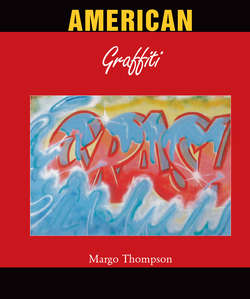Читать книгу American Graffiti - Margo Thompson - Страница 17
На сайте Литреса книга снята с продажи.
Subway Writers
DONDI
ОглавлениеDONDI, a Brooklyn-based writer, began tagging trains in 1974. He formed a working relationship with DURO soon after he began writing, and later was influenced by SLAVE from the Fabulous Five and NOC 167.[77] His crew, the Crazy Inside Artists (CIA) rivaled the Fabulous Five’s dominance on the IRT lines 2 and 5 by the end of the decade.[78] Other writers looked up to him for his graphic fluency that he refined by making up new tags, new arrangements of letters.[79] DOZE described DONDI’s mastery: ‘His style was very logical and smart. He taught me how the letter flows and how it should go in certain directions, that the arrows should always meet at the serifs. He taught me the art of flow and balance. His letters were simple, but always balanced’.[80] His ASIA piece from 1981 showed the flow that DOZE admired. The first A’s cross-bar tied directly to the lower curve of the S, the I reversed the curve and the second A leaned into it, while the bottom of the I kicked into the second A’s cross-bar. The far leg of the second A curved to echo the S and close the tag, while two arrows extended away, shooting energy outward. This final letter covered the subway doors, and the arrows pointed in the direction the door opened. DONDI added a boast at the top, ‘DONDI rocks again’ and typically credited his crew, CIA, at the bottom. His graphic facility enabled him to change his lettering style depending upon the audience he intended to address: a complex wild style with densely interlocked letters drew the notice of writers, while a plainer style was legible to a broader public.[81]
SIEN 5, BFK, date unknown. Aerosol paint on freight train car. Destroyed.
CLOWN, Untitled, date unknown. Aerosol paint on freight train car. Destroyed.
DONDI used unadorned letters in ‘Children of the Grave’, a theme to which he returned three times, in 1978 and twice in 1980. These were whole car, top-to-bottom pieces: ‘DONDI’ in italic capitals covered the windows. The phrase ‘Children of the Grave’ referred to a song by the heavy metal band Black Sabbath, and was written inside the letters of the tag. In ‘Children of the Grave Return, Part 2’, the letters in olive green, yellowy-tan, orange-pink, and ice blue were blocky and three-dimensional and marched across the length of the car. In the third version, ‘Children of the Grave Again, Part 3’, the letters were in a similar palette but more curvilinear, with a loop at the top of the O that joined the N’s serif in a flourish, outlined in black and casting black shadows. The effect was clean and elegant. The decorative effects lay outside the lettering, where DONDI painted a hand reaching in from the left in ‘Part 2’ and appropriated two child figures from comic-book artist Vaughn Bodé in ‘Part 3’. These elements and the caption lent the compositions their emotional resonance, a tinge of despair. The writer’s name by contrast was slick and declared a subjective presence in the face of the lack of opportunity implied by the song title. This was social criticism, rejecting the perception popularised in media such as The New York Times that subway writers were antisocial, juvenile delinquents.[82] Rather, DONDI’s piece suggested that they were children in a dangerous environment, facing a bleak future, yet claiming their right to participate in the public sphere by writing on trains.
‘Children of the Grave, Part 3’ established DONDI’s reputation beyond his fellow writers: photographer Martha Cooper documented its execution. In her pictures published in Subway Art in 1984, DONDI’s seriousness about his craft is evident and resembles a fine artist’s studio practice. Writers prepared sketches before tackling trains to devise their designs, even labeling the diagrams with the names of aerosol paint colours to determine how much of each would be needed. All of this advance work is evident in the Subway Art spread, where DONDI has his paints arrayed along an open subway car door, in front of his sketchbook where he has outlined his piece and drawn the cartoon children for reference.[83]
77
Witten and White, 11, 18–19.
78
Stewart, 408; Witten and White, 18–19.
79
Guy Trebay, “Getting Up: Dondi and the Late, Great Art of Graffiti,” The Village Voice, 4 May 1999, 39.
80
Miller, 123.
81
Cooper and Chalfant, 70–1.
82
Austin, 154–7.
83
Cooper and Chalfant, 32–7.
